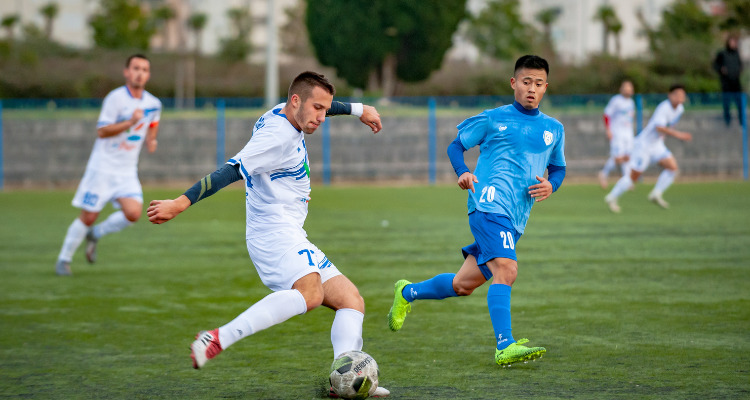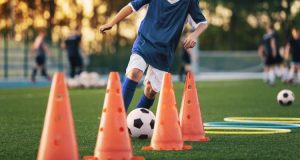
When devising a comprehensive training regimen tailored to each position on the soccer field, it is crucial to establish a well-defined strategy. In this article, our focus will be on formulating an effective training program specifically designed for fullbacks in soccer.
The fullback position, both left and right, has a very defined defensive role. It is true that in some very specific situations, they can move up to the attack, becoming an offensive fullback, although that role is usually marked by the figure of the center back.
What are fullbacks in soccer?
Fullback soccer players, typically stationed in the defensive zone, hold a crucial role on the field.
Their responsibilities are multifaceted, requiring them to cover the goal, provide support to teammates on the wings, and swiftly return to their starting position alongside center backs.
This complexity demands specific physical and technical attributes, making training sessions imperative for the development and enhancement of the skill set required for effective fullback play.
Physical and mental characteristics of a good fullback in soccer
- Fast speed changes.
- Immediate strategic decision-making in the face of strong opposition
- Taking care not to leave any open places.
- Returning to his original position
- Possess a 360º spatial vision of the field.
- Total mastery of ball control and passes, short and long.
- Fluent communication skills with the rest of the team.
- In times of intense stress, the mental ability for quiet and introspection is essential.
Upon grasping the nuances of a soccer fullback’s physical attributes, we can progress to developing a highly effective training program for our athletes in this position.

fullbacks soccer drills
The coach’s initial step should be to outline the tactical and technical goals that must be met, such as increasing defensive timing, ball stealing, dribbling, or marking.
The appropriate physical targets for these goals can then be created depending on the objectives in question. Consider the ability to react, change speed, jump, or boost physical build for higher strength in one-on-one play.
We recommend using Bcoach, a multidisciplinary tool for professional football coaches that will serve as a multidisciplinary tool to design tasks, describe all types of plays through its virtual whiteboard, and keep track of the statistics of both players as well as the matches and trainings that are carried out.
Rondos
Mastering footwork is best achieved through rondos exercises, specifically tailored for fullback soccer players. These drills emphasize precision and fine control in ball handling, constituting a fundamental aspect of a fullback’s skill set.
Simultaneously, these exercises immerse players in an intensive practice of plays, fostering a coordinated and strategic approach. The objective is to adeptly execute passes, preventing central players from intercepting the ball during the exchange.
In the following simulation, we see the example of two teams with six players in each of the zones. The ball is passed from player to player with the intervention of several outsiders, who will come in and out and be the attackers and try to intercept the ball.
Passing and Receiving
Sharpening passing and receiving skills is fundamental for fullback soccer preparation, as these plays constitute integral aspects of their on-field responsibilities.
To elevate performance in these areas, consider incorporating the running pass drill. This dynamic exercise involves setting the ball in motion, prompting attacking players to engage while fullbacks strategically evade interception attempts.
Another effective yet straightforward practice involves arranging multiple wingers in a linear formation, with an equivalent number of players forming a parallel row in front of them. The objective is to execute precise passes to the players ahead, gradually increasing the distance between them at regular intervals, fostering accuracy and adaptability in fullback play.
Marking the opponent and stealing the ball
Beyond their defensive duties, fullbacks in soccer are entrusted with the task of containing and encircling opposing players as they approach the goal area, aiming to intercept and clear the ball.
To hone these skills, a prevalent marking exercise involves one-on-one scenarios, where the attacker seeks to maintain possession, while the fullback defends and endeavors to seize control. Alternatively, the fullback initiates the play, holding the ball at their feet and resisting the opponent’s attempts to take it away.
In the realm of defensive drills for fouls and corners, emphasis is placed on covering attackers. These maneuvers often involve multiple players or simulations across different field zones.
A strategic recommendation is to employ crossing techniques to thwart potential ball drops. This simple yet effective exercise requires only two players, with one strategically positioning their body over the ball, obstructing and impeding the opponent’s attempts to gain possession.

Attack – Defense
One of the fundamental aspects to work on during training for fullbacks is attacking and defensive plays.
With this objective in mind, during the training sessions we work specifically on shooting exercises.
To illustrate this, we leave an example performed with the Bcoach App, where a long delivery is carried out towards the defensive line with the aim of clearing the ball to the sides in a 1-3.
Another technique is for enhancing fullback soccer skills involves pairing players and strategically positioning cones or markers equidistant from each other on the field. The attacking player takes the ball towards one of the cones, and the defending fullback endeavors to dispossess them using a lateral tackle.
Upon reaching the designated position, a dynamic shift occurs, as roles reverse, and both players race towards the opposing cone. This not only refines lateral defending skills but also seamlessly transitions the defender into an attacking role, fostering versatility in fullback play.
These examples provide a glimpse into fullbacks soccer training drills. For a more comprehensive guide, explore our goalie training guide.



